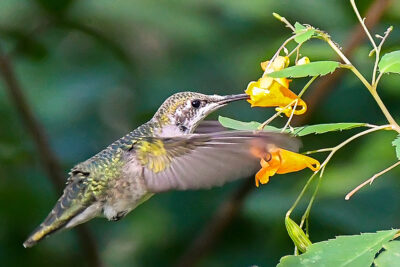
One of the more spectacular of our migratory birds in the Americas, hummingbirds are found exclusively in the New World, making this a truly American bird. While most of the over 300 species of hummingbirds are found in Central and South America, around a dozen species of these tiny gems searching for food and shelter grace many a garden in North America. If you live in an area where hummingbirds nest or migrate through, with very little effort, you can make your yard or patio both beautiful and a haven for hummingbirds. Here’s the lowdown:
- Flowering vines are ideal for hummingbirds – native species like Trumpet Honeysuckle (Lonicera sempervirens) and Trumpet Creeper (Campsis radicans).
- Two other widespread and important species are Cardinal Flower (Lobelia cardinalis), Spotted Jewelweed (Impatiens capensis);
- Columbines are a hummingbird favorite, including Wild or Eastern Red Columbine (Aquilegia canadense) in the East and Western Columbine (A. formosa) in the Pacific Northwest.
- Colorful bee balms – native species are M. fistulosa and M. didyma.
- There are plenty more — for a more complete list of native plants to lure in hummers, along with lots of tips on making your yard a hummingbird haven check out this article from American Bird Conservancy. And check out Audubon’s Plants for Birds database for the exact right plants for your zip code.
- Mix 1 cup sugar into 4 cups of boiling water
- Stir until sugar is completely dissolved
- Let cool to room temperature
- Fill your feeders
- Put the rest of the mixture into the refrigerator and use it up within a few days – make sure it’s room temperature before you put it out for the hummers
3 – Fresh open water is essential for both drinking and bathing and you can provide a shallow bath and even a mister in hot weather which will please your hummingbirds no end!
4 – Nesting material is important in the season so fuzzy plants of the right kind are a good idea so the birds can strip the fluff off to line their nests. Cinnamon Fern and Pussy-willow are good choices, but dandelion and thistles also provide nesting materials.
5 – A safe place to nest, rest during storms or pass through is important when your weight is measured in single-digit grams. This means it’s best to practice organic gardening without insecticides, herbicides, or lawn chemicals – especially anything containing neonicotinoids that can be fatal to birds and bees. If you attract birds to your yard with native plants, you won’t need pesticides as many birds, including hummers, eat insects. So using pesticides not only eliminates a food source for the hummingbirds but if they do eat poisoned insects, there can be a build-up of the poison in their system which can eventually prove fatal.
6 – And it goes without saying that it’s important to keep kitty in the house or in her catio year-round, but especially during nesting and fledging season!
For more information on how to plan your garden and what to plant for hummingbirds, check out this article from Audubon.